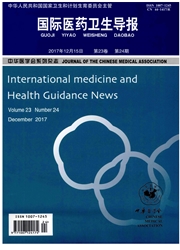

 中文摘要:
中文摘要:
目的分析极低出生体重儿(very low birth weight infant,VI.BWI)出生1周内预防性使用抗生素对其生后28d肠道菌群的影响,为研究VLBWI肠道菌群分布特征及生长规律提供参考。方法选择2016年8月至2017年2月在本院新生儿科住院的VLBWI,出生1周内预防性使用抗生素为抗生素组,无抗生素暴露为对照组。收集第1d和第28d的粪便样本,利用16SrRNA基因测序方法,采用MiSeq测序平台双端测序模式对样本进行高通量测序。结果①两组婴儿各5例,两组第1d粪便菌群属水平E未发现差异菌,多样性对比无统计学差异(P=0.23);②两组婴儿第28d粪便菌群属水平上差异的菌有脲原体属、嗜血杆菌属、小动杆菌属和盐单胞菌属,其中不动杆菌属和盐单胞菌属抗生素组增多,脲原体属和嗜血杆菌属对照组增多,多样性对比无统计学差异(P=0.16)。结论出生1周内预防性使用抗生素会增加VBLWI肠道不动杆菌属和盐单胞菌属含量。
 英文摘要:
英文摘要:
Objective To analyze the effect of empirical antibiotic therapy on the intestinal microbiota of VLBW (very-low-birth-weight) infants on the 28th day, to provide the reference for VLBWI intestinal flora distribution and growth rule. Methods Collected VLBW infants who were treated in NICU of our hospital from August 2016 to February 2017, the infants treated with antibiotics as antibiotics group, while other infants treated with antibiotic free as control group. Fecal samples were collected on postnatal I st day and 28th day. Total bacterial DNA was extracted. Bacterial taxa were identified by high-throughput 16s rRNA gene sequencing with MiSeq sequencing platform. Results (1) 5 VLBW infants were assigned to antibiotics group and other 5 VLBW infants were assigned to control group. The fecal samples on the 1st day had no significant variation on genus level (P〉0.05), without statistically significant difference in the Shannon-index / Sphingomonas (P=0.23). (2) Compared with control group, antibiotics group had increased relative abundance of Acinetobacter and Halomonas in fecal samples on the 28th day, decreased relative abundance of Ureaplasma and Haemophilus, without statistically significant difference in the Shannon-index / Sphingomonas (P=0.16). Conclusion Empirical antibiotic therapy within 1 week in VLBW infants could increase intestinal Acinetobacter and Halomonas content.
 同期刊论文项目
同期刊论文项目
 同项目期刊论文
同项目期刊论文
 期刊信息
期刊信息
